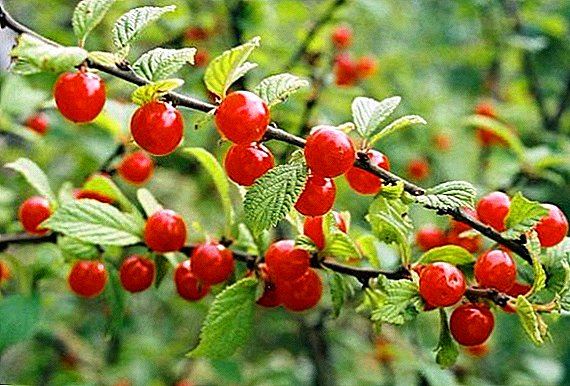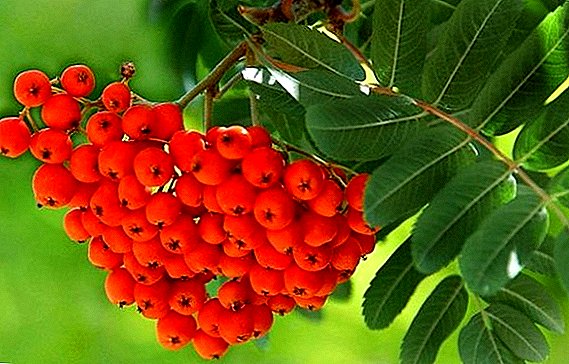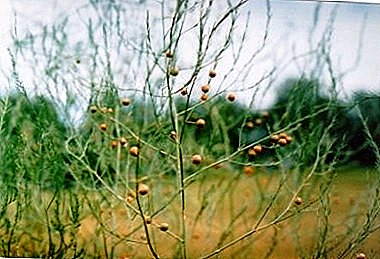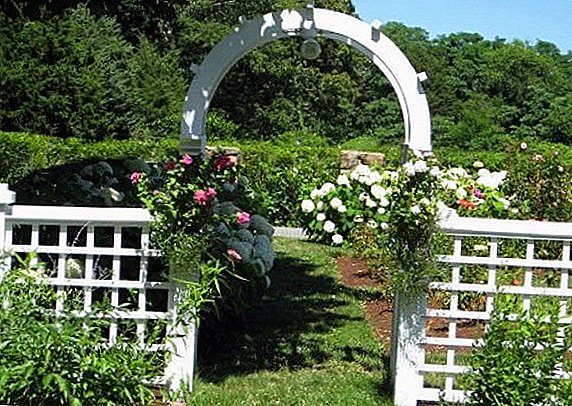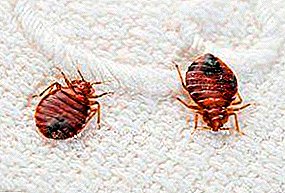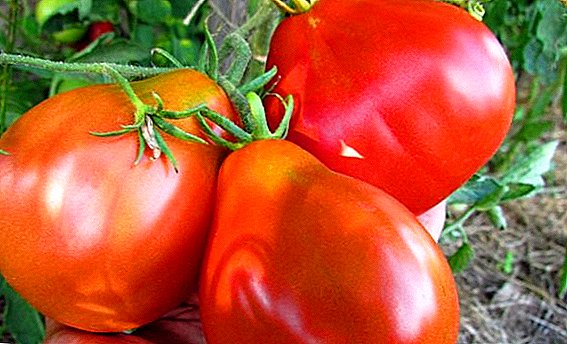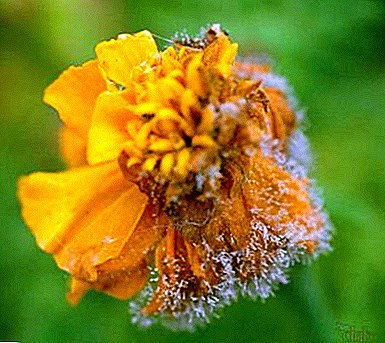
Marigolds - one of the most popular summer flowers that adorn the flower beds, areas and even vegetable beds. Cheerful, bright and lush, marigolds create a wonderful mood when looking at them.
The reason for the wide distribution of marigolds is due to their unpretentious, trouble-free care, long and bright flowering.
Diseases of marigolds can have various causes. The article will discuss what problems in the care of these flowers can be handled and how to do it.
What are these flowers?
Marigolds are flowers that belong to the Astrov family (Compositae). This name flowers received because of their petals, which have a velvet texture. In total there are about 53 varieties of marigolds.
What does a plant look like?
- The stems are straight, developed, which form a bush with a height of from 20 to 130 centimeters.
- The root system is pivotal.
- The leaves are pinnatisect, arranged alternately on the stem. In rare cases, there are marigolds with whole leaves. Color from lime to dark green.
- Different varieties of marigolds have different inflorescences: from flattened to spherical, from yellow to orange. Some species combine several colors in the inflorescence.
Due to the long flowering (until the first frosts) marigolds are the favorites of gardeners. It is not necessary to plant these flowers in the open field, some gardeners plant marigolds in pots or pots, hang them on the windows or put them on the porch. About whether it is possible to grow this plant at home in a pot, read here.
Common diseases and growing problems
In most cases, marigolds are unpretentious and resistant to diseases, attacks by pests. But when weakening the protective properties of infection can occur. Most often the following pests and diseases appear.
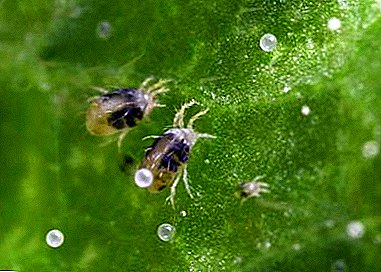 Spider mite The risk of infection grows in arid soil.
Spider mite The risk of infection grows in arid soil.- Rot and fungus. Appears in a wet soil.
- Snails and slugs. Suitable environment is wet earth. They gnaw leaves, leave the larvae.
- Gray rot. The disease progresses at low temperatures in too wet soil.
In addition to diseases and pests the gardener may have a number of problems when growing marigolds.
- Slow growth due to lack of moisture in the soil.
- Inexpressive and small inflorescences due to lack of moisture.
- Root decay with frequent rains.
- Stop in growth due to a sharp decrease in temperature to +10 degrees, which is accompanied by redness of the leaves.
It is also important to know that the abundance of fertilizers and fertilizing will lead to an increase in green mass, and the inflorescences will be small, sparse and dull. What and how to feed the plant for abundant flowering, we told in this article, and what these beauties look like and what to do if they do not want to bloom is described in detail in another material.
You can read about the diseases and pests of the flower here, and we wrote about the methods of dealing with the most common diseases and insects in this material.
Causes of decay
There are several factors that lead to wilt.
- Shine. The leaves dry up depending on how the sun's rays fall on the plant. Direct rays can cause burns. If the gardener limited growing and hiding them from the sun when growing seedlings of marigolds, then after planting in open ground the leaves dry out from an overabundance of sunlight.
- Water. Drying of the marigolds is a process that can indicate that the plant receives less liquid. Marigolds for intensive growth and lush flowering require daily watering. At the same time, it is important to prevent moisture stagnation, since in such an environment a dangerous fungus quickly appears.
- Place of sowing. When planting flowers, many gardeners limit the space between the bushes. Due to this restriction, the buds and leaves of the plant begin to wither and dry. When planting marigolds, it is not necessary to part the wells and take free space from the plant.
Attention! The optimal distance between the bushes depends on the type of marigolds. For tall varieties, a 40x40 scheme (40 cm between bushes and rows) is suitable. For sredneroslyh - it is 30x30, for undersized - 20x20.
We make a diagnosis
| Problem | Description and Symptoms |
| Blackleg | Common disease. The process by which the lower part of the stem darkens, it begins to rot. |
| Root rot | At an adult plant leaves turn yellow, buds fade. |
| Viral diseases |
|
| Spider mite | Appears in a dry soil, in which grow marigolds. The risk of infection increases in enclosed spaces (greenhouses, houses). The insect eats leaves. Symptoms of infection - thin cobweb, light spots and yellow leaves. |
| Slugs and snails | The diet of pests - leaves, flowers, stems. On the infection says silver trail of dried mucus on the leaves, the specific damage to the bush. |
| Aphid | Tiny insects that eat buds. Symptom of infection - small holes on the green mass. Also the pest covers the leaf plate with a viscous liquid - pad. Large colonies can destroy a bush in a short period of time. |
| Caterpillars | A sign of a parasite attack - leaves nibbled on the sides and in the center. Twisted leaves suggest that the larvae laid larvae in them. |
Why do parts of a plant dry up and blacken buds?
 If the flower stopped growing, became sluggish, the leaves began to dry and the stem or bud turned black - these are symptoms of a bacterial lesion. The main reason is excessive watering. Marigolds love water, but the soil is too wet for them to be much worse than over dried.
If the flower stopped growing, became sluggish, the leaves began to dry and the stem or bud turned black - these are symptoms of a bacterial lesion. The main reason is excessive watering. Marigolds love water, but the soil is too wet for them to be much worse than over dried.
Also provokes infection with excess fertilizer, clodded clod of earth.
Bacterial damage occurs in the form of:
- bacterial rot;
- bacterial blotch and burns;
- vascular bacteriosis.
What to do?
General actions for any problem - preliminary assistance to the plant. All damaged or badly infected parts must be removed with a scissors, pruner. For 2-3 days, the plant should be left without watering to dry the soil. Be sure to establish a watering schedule, normalize the moisture balance.
Further actions depend on the diagnosis.
| Diagnosis | What to do? |
| Blackleg |
If the disease appeared on the seedlings of marigolds, it must be destroyed. |
| Root rot | It will only help spraying chemicals:
Popular methods of struggle - watering the soil with a solution of potassium permanganate, falling asleep the damaged part of the root with crushed chalk or ash. |
| Bacterial infection | The plant is transplanted and irrigated with a bactericidal fungicide:
Garden equipment is sanitized. Prevention - spraying of marigolds with biobactericides (Fitolavin, Fitosporin). |
| Pest attack |
|
You can get rid of slugs by scattering small plates, pieces of apple or potatoes at night near the flower. In the morning, the gardener will need to collect these elements and the pests stuck in them. Prevention of infection - mustard powder scattered around marigolds or ash.
If nothing helped
If folk recipes and chemical products have not brought effect, the plant continues to wither, you can go to extreme measures.
- The problem did not affect the root. Marigold cut under the root, for 12-24 hours to pour and cover with polyethylene. Such a solution is advisable, if the flower got burned in direct sunlight, did not receive water, its green mass was eaten by flying insects.
- If the root is affected by rot, the black leg progresses - the plant must be removed. Also removal is necessary when attacking some pests (nematodes). The flower must be dug up with the root, taken out of the site and burned. On the site of an infected plant during the year can not be planted any plants.
Marigolds are beautiful flowers that will decorate any part of their bloom. In order for the plant to be pleasing to the eye and not to hurt, it is important to monitor its condition, do not overfill or overdry. Fertilize rationally, and only healthy marigolds. If there are signs of infection, take immediate remedial measures.


 Spider mite The risk of infection grows in arid soil.
Spider mite The risk of infection grows in arid soil.